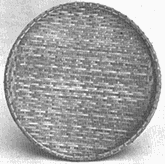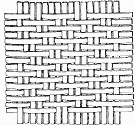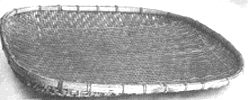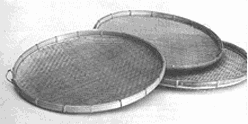| Product 1:  This product is a circular winnowing tray (fig.579). The
mat is woven in a five-up-two-down weave, with each consecutive strip being staggered by
two strips (fig.580). This product is a circular winnowing tray (fig.579). The
mat is woven in a five-up-two-down weave, with each consecutive strip being staggered by
two strips (fig.580). Every third strip from one set uses the
outer layer of bamboo. The mat is sandwiched between two bamboo rings. The three rings are
bound tightly together to hold the mat in place. This bamboo product is very expensive and
is made by a number of craftsmen. Every third strip from one set uses the
outer layer of bamboo. The mat is sandwiched between two bamboo rings. The three rings are
bound tightly together to hold the mat in place. This bamboo product is very expensive and
is made by a number of craftsmen.
Product 2:
 This is an oblong winnowing tray with rounded corners (fig.581).It
has the same weave as the circular winnowing tray, but the structure on the periphery of
the mat is a simple twill with shorter floats. This helps to maintain the slightly rounded
corners. The mat is held between two half splits of cane, which are bound together
sandwiching the mat between them. This tray is slightly deeper than the circular winnowing
tray. .. This is an oblong winnowing tray with rounded corners (fig.581).It
has the same weave as the circular winnowing tray, but the structure on the periphery of
the mat is a simple twill with shorter floats. This helps to maintain the slightly rounded
corners. The mat is held between two half splits of cane, which are bound together
sandwiching the mat between them. This tray is slightly deeper than the circular winnowing
tray. ..
Product 3:
 Screen is are sieves used as dry or wet strainers to sift grain or
wash vegetables (fig.589). the basic structure of the screen is a mat stretched within a
stiff circular rim, very similar to the structure of the circular winnowing tray. The main
difference lies in the structure of the mat, which in the case of screen is made with an
open weave. Screen is are sieves used as dry or wet strainers to sift grain or
wash vegetables (fig.589). the basic structure of the screen is a mat stretched within a
stiff circular rim, very similar to the structure of the circular winnowing tray. The main
difference lies in the structure of the mat, which in the case of screen is made with an
open weave.
Mat weave
The size of the gaps between the elements
determine the function of the screen. Generally, the width of the strips used increases
with the width of the gaps required. A square mat is woven from the centre outwards and
two pairs of wide bamboo strips, one in each direction, are interlocked in a cyclic
pattern. Subsequently, narrower bamboo strips are woven on each side of the first four, in
a twill weave. 
Rim
 The edges of the mat are woven with wider strips in a
closely-packed twill weave. The mat is stretched and sandwiched between two rings of
bamboo and the portion which protrudes above the top of the rings are cut off. The rings
are tied together with a cane split passing through the mat. This method is used to
produce both coarse and very fine sieves. The edges of the mat are woven with wider strips in a
closely-packed twill weave. The mat is stretched and sandwiched between two rings of
bamboo and the portion which protrudes above the top of the rings are cut off. The rings
are tied together with a cane split passing through the mat. This method is used to
produce both coarse and very fine sieves.
|
 This product is a circular winnowing tray (fig.579). The
mat is woven in a five-up-two-down weave, with each consecutive strip being staggered by
two strips (fig.580).
This product is a circular winnowing tray (fig.579). The
mat is woven in a five-up-two-down weave, with each consecutive strip being staggered by
two strips (fig.580). Every third strip from one set uses the
outer layer of bamboo. The mat is sandwiched between two bamboo rings. The three rings are
bound tightly together to hold the mat in place. This bamboo product is very expensive and
is made by a number of craftsmen.
Every third strip from one set uses the
outer layer of bamboo. The mat is sandwiched between two bamboo rings. The three rings are
bound tightly together to hold the mat in place. This bamboo product is very expensive and
is made by a number of craftsmen.  This is an oblong winnowing tray with rounded corners (fig.581).It
has the same weave as the circular winnowing tray, but the structure on the periphery of
the mat is a simple twill with shorter floats. This helps to maintain the slightly rounded
corners. The mat is held between two half splits of cane, which are bound together
sandwiching the mat between them. This tray is slightly deeper than the circular winnowing
tray. ..
This is an oblong winnowing tray with rounded corners (fig.581).It
has the same weave as the circular winnowing tray, but the structure on the periphery of
the mat is a simple twill with shorter floats. This helps to maintain the slightly rounded
corners. The mat is held between two half splits of cane, which are bound together
sandwiching the mat between them. This tray is slightly deeper than the circular winnowing
tray. .. Screen is are sieves used as dry or wet strainers to sift grain or
wash vegetables (fig.589). the basic structure of the screen is a mat stretched within a
stiff circular rim, very similar to the structure of the circular winnowing tray. The main
difference lies in the structure of the mat, which in the case of screen is made with an
open weave.
Screen is are sieves used as dry or wet strainers to sift grain or
wash vegetables (fig.589). the basic structure of the screen is a mat stretched within a
stiff circular rim, very similar to the structure of the circular winnowing tray. The main
difference lies in the structure of the mat, which in the case of screen is made with an
open weave.
 The edges of the mat are woven with wider strips in a
closely-packed twill weave. The mat is stretched and sandwiched between two rings of
bamboo and the portion which protrudes above the top of the rings are cut off. The rings
are tied together with a cane split passing through the mat. This method is used to
produce both coarse and very fine sieves.
The edges of the mat are woven with wider strips in a
closely-packed twill weave. The mat is stretched and sandwiched between two rings of
bamboo and the portion which protrudes above the top of the rings are cut off. The rings
are tied together with a cane split passing through the mat. This method is used to
produce both coarse and very fine sieves.